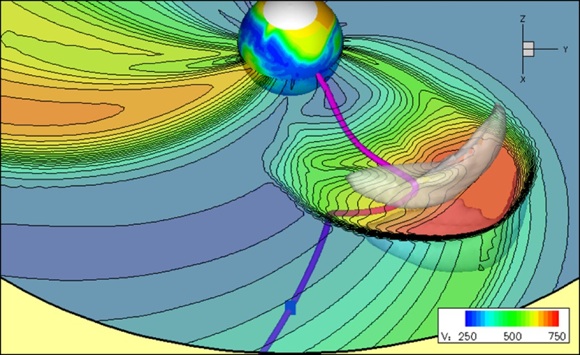This article is more than 1 year old
World's first space met office goes live
Will offer warnings of ion storms, 'space Katrinas'
The world's first proper space weather service is now going live, according to the boffins setting it up. Forecasts and warnings of fearful radiation storms, ion deluges etc are expected to be invaluable to those operating in the fields of communications and satellites – and life-critical for future astronauts travelling beyond low Earth orbit.

The space met boys say Mars orbit is being hit by an absolute elephant's arsehole at the moment, skipper
Boffins working at the US National Weather Service and the Center for Integrated Space weather Modeling (CISM) reported the standup of the space-weather service at a conference in Seattle yesterday.
"It's very exciting to pioneer a path from research to operations in space weather," said CISM top boffin Jeffrey Hughes. "The science is having a real impact on the practical problem of predicting when 'solar storms' will affect us here on Earth."
Hughes and his fellow space forecasters believe they will be able to provide "one-to-four day advance warning" of major extraterrestrial weather events such as plasma downpours and coronal mass ejections belched out of the Sun towards Earth. It's already the case that such events can cause serious collywobbles in satellites and other orbital hardware, and some kinds of groundbased electronics, radio communications, etc can be affected too.
A really major solar storm, of a sort not seen since before the modern electronic age, is thought by some scientists to have the potential to be a "space Katrina" – to strike humanity's modern technological civilisation with devastating impact across much of the globe, causing devastation equivalent to a huge electromagnetic pulse (EMP) bombardment*.
Much of the damage or disruption from major space storms or particle hurricanes could be avoided with adequate warning – hence the establishment of the USA's nascent space met office.
The human race already has a large number of unmanned spacecraft – satellites, probes etc – deployed partially or entirely outside the protective magnetic fields of Earth. This environment is hostile both to electronics and to living things: the only humans ever to travel there, the Apollo moon astronauts, survived by only making short forays and by fortunately never being struck by a major space storm.
Various nations including Russia and China have stated aspirations toward manned Moon missions in future, and the USA now intends to go still further – to the nearer asteroids and then on to Mars. Heavy radiation shielding able to protect deepspace explorers from space weather will probably not be practical (unless new forcefield tech can perhaps be developed) and journeys are expected to last months at the very least, so the science of space weather forecasting will probably be critical to such missions' success.
In the meantime, the CISM space met office will have quite enough to do keeping satellites and other increasingly sensitive tech infrastructure out of harm's way.
Those interested can find out more at the CISM website. ®
Bootnote
*At the moment the only known way of achieving such a bombardment would be the triggering of a large number of nuclear weapons above the atmosphere – though less drastic methods have long been a military goal and/or homeland-security bogeyman.
